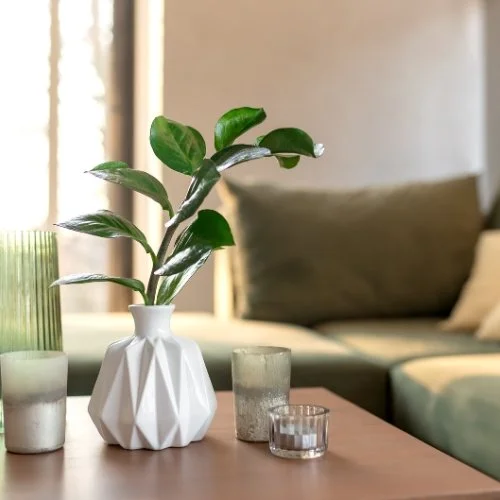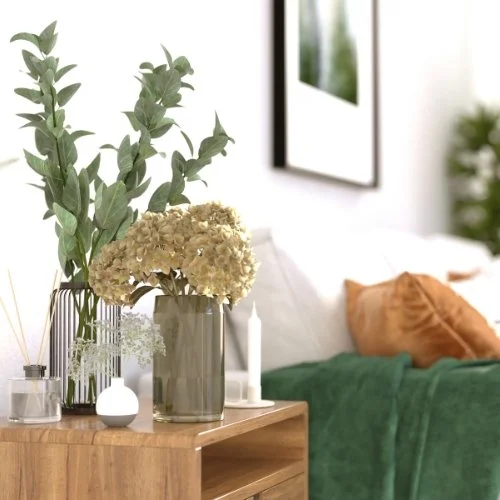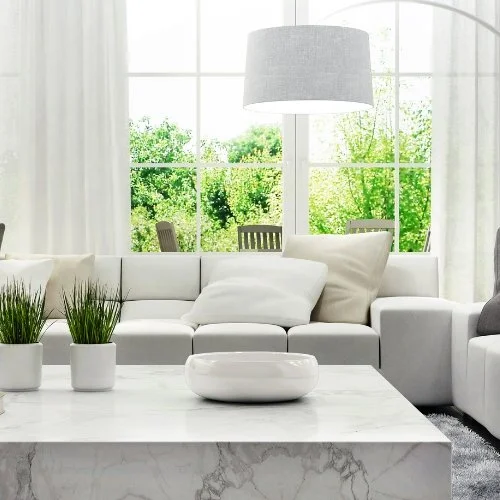Tips to Design a Home That Boosts Wellbeing
Our homes have become more important than ever over the last few years and creating the best environment possible for our ourselves, our families, our health and general and wellbeing has become a priority for many of us.
What makes a space feel like a home? At the most basic level we need shelter, beyond that comfort, beauty, and connection with others. Our homes are essentially a place of refuge which we make our own by adding comfort and beauty through furniture and furnishings, based on interior design inspiration.
Health and wellbeing have been at the forefront of the healthcare industry for a while now. We have learnt that self-care and mindfulness enhance our sense of wellbeing, but what about our environment, the space in which we spend much of our time? We know that practising mindfulness reduces stress levels and helps improve the quality of sleep, can we take this a step further? Is there a way to boost our wellbeing at home? Can the principles of mindfulness and interior design work together?
The good news is yes, they can!
Neuroarchitecture is a term we use to describe how the brain and body react in buildings. In essence, we respond to the quality of air and light, the intensity of sound, and the colour, texture, and size of all places in which we spend any time.
There is an inextricable link between interior design and mental wellbeing
We often don’t acknowledge the nuances within an interior design scheme and how much of an impact it can have on us emotionally. I’m sure you’ve had the experience of walking into a space that feels and looks so inviting and calming, that you just want to spend time there. Conversely, you also have experienced walking into a space where it feels the exact opposite and you can’t wait to leave as quickly as possible. Perhaps you have responded to spaces like this, and at times your home feels like this too, but you aren’t sure about what changes to make.
We will be exploring a few different design elements, ranging from colour and texture to bringing the outside indoors, which you can use to create a space that makes you feel at home.
Create a calm space
Our homes reflect us, our values and interests. This quote by Amy Wax, a colour design consultant sums it up perfectly, “The colours and design of a home should be a reflection of the people who live inside.”
As I like to say, “Your space is at the heart of everything”, whether you live alone or share your living space with family or friends, home is an important part of your identity and has many different functions. It has become increasingly important in this unstable world in which we live to create our homes as a sanctuary, in which we can withdraw and rejuvenate.
Our busy lives bombard us with so much information and instant responses which, necessitates the creation of a space where we have a choice of how calm or relaxing, we would like it to be.
Create areas of calm within your space, free of digital distraction where you can relax and chat with family and friends, for example, a balcony (pot plant gardening) or making a space for a creative hobby. Instead of designing a living room around the TV, consider designing it around people. Where in your space could you enjoy the sun, or have a quiet cosy spot for reading or painting?
Light it up
Natural light is very important for our body’s natural rhythm, positivity, and productivity. Daylight is essential for maintaining a sense of wellbeing and a healthy mood. Have a look at your space and the windows, can you arrange your furniture, including your desk, so that you can maximise the amount of light coming in during the day? If you have a great view even better.
Layering your lighting by combining ceiling lights, table and task lamps and decorative candles helps to creative a positive space. Using dimmer switches with your lights helps to achieve a relaxing environment whilst using brighter lights in larger areas and in spaces where you need to be productive.
If you wish to harmonise your body with your environment, then interior lighting should mimic the patterns of daylight, which changes over the course of the day. This has a remarkable effect on our circadian rhythms and the way we feel. Layering lighting cleverly means that you can change the lighting for any given mood and time of day.
Turn the lights down
As well as maximising daylight, it’s also important to minimise light at certain times of the day so there should be areas which are snug and dimly lit too.
Light and darkness are very important to our circadian rhythms, yet we often don’t realise that we are exposed to light from the minute we wake up to the minute we go to sleep, in the form of our computers, tablets and phones. This exposure to blue light, or too much light, in the evening affects your sleep and your mood, playing havoc with your circadian rhythm.
My advice, plan a layered lighting scheme using lamps and dimmer switches, as this low lighting will help your mind and body unwind and relax in the evening; keep screens (phones, tablets, TV’s) out of the bedroom and ensure that you install blackout curtains or blinds.
Lower the noise level
Sound impacts our wellbeing, sometimes a sound is pleasurable and sometimes not. We can manage where sound goes in our homes, for example when we need to concentrate, communicate, or rest by using different materials that absorb or reflect sound so that sound is distributed differently within our homes.
Acoustic panelling can avoid noise transference between rooms. Fitting an internal pocket door, which can be closed in the evening creates a quieter space.
Other ways of managing noise, would be to incorporate soft materials, think carpeting and artwork into your room which also absorb sound.
Connect with nature
We all know how good it feels to come home after a walk outdoors in nature or a trip to the beach. Have you ever wondered why rustling trees, or the shimmer of water is so relaxing, and why many people choose to invest more in homes that offer beautiful views?
In 1984, the biologist E. O. Wilson, used the term biophilia to refer to the way humans need and seek out connections with nature. Studies have found that elements of the natural world or even reminders of them have a positive effect on mental and physical health. The principles of biophilic design focus on daylight, free-flowing air, natural organic materials, and houseplants as well as pictures, textiles and coverings that are reminiscent of flora, fauna, and greenery.
In our homes, we can translate this by ensuring we have a connection with living things, plenty of houseplants and large windows that provide a view of greenery outside. We can include natural materials and textiles in the design of your interior like wooden flooring and furniture rather than plastic or laminate, pictures of nature and botanical designs on soft furnishings or wallpaper.
Indoor plants, remove harmful chemicals from the air, such as those in paints and varnishes, new carpets and MDF, they absorb noise and reduce dust, lower blood pressure, help concentration, improve memory, promote relaxation, and make rooms look cared-for and welcoming. Some wellbeing boosting plants that you could add to your space the Peace Lily, Boston Fern, Fern, Gerbera Daisy, African Violets, Ficus Weeping Fig, Snake Plant, Spider Plant and English Ivy.
Natural and sustainable materials connect us with nature and bring texture, along with a real sense of calm and wellbeing. Sisal flooring and wicker furniture and decorative items such as lampshades and pendants are widely available now too. Sisal has neutral tones and texture and is extremely hard-wearing, making it ideal for flooring. In addition, as it is naturally moth and dust-mite resistant, it’s a healthy solution for those who suffer from asthma, eczema, and other allergies.
Mixing fabric textures is vital to achieving a truly cosy feel, so layer velvets, weaves, knits and cottons across soft furnishings to tie your look together.
Space, space space
People often see open spaces as more beautiful than enclosed ones, but this doesn’t mean your rooms have to be large. Smaller spaces, if well designed can also be seen as beautiful.
The key is to design a room that feels spacious and functions well, rather than purely focusing on size or whether it’s open-plan or not. If a living room is small, creating a layout and a connection to the outside ensures that the space flows.
An organised, tidy space ensures a more relaxed, calm, and positive outlook. The mind associates a busy, cluttered, and untidy environment with disorder and chaos, which results in overwhelm and the feeling of not knowing where to begin. My advice, simply take one room at a time or one drawer at a time within that room. Organise what you really need to keep, and your productivity will improve which in turn will allow you to relax in a more ordered space.
The layout of a room also impacts the way you feel. Feng Shui promotes that positive energy flows through a room when it is set up properly. A well-considered layout ensures that your space is inviting and has a positive atmosphere. Remember to make sure every space in your home has a function. Choose furniture which is proportionate to the space or hang a large mirror on a back wall to make a space feel larger.
Clear the clutter
A recent study on the link between procrastination and clutter found that participants with cluttered homes reported a decrease in life satisfaction. Is this perhaps something you need to consider if you keep putting off sorting out that clutter? Clutter creates cognitive overload, overstimulation, and distraction from the environment, and therefore no relaxation.
It makes sense, then, to put storage at the top of your list when designing your home. Declutter first, so you’re only left with the final edit of your belongings, then plan storage to perfectly match your needs.
A tidy space works wonders for our mental clarity and overall health. Try the 10-minute bin-bag challenge every day. Set a timer, take a bin bag, and go around your home, collecting items no longer required and dispose of them thoughtfully. After a week, you'll find that you have much less clutter in your home, so you'll have a calmer, tidier mind, too.
Colour
The psychology of colour has been around for some time and numerous studies show that certain shades of a colour can highlight specific emotions and feelings. The Little Book of Colour states that lighter shades of blue are associated with mental calm, serenity, and reflection, yellow makes us feel more positive and optimistic and green is a restful colour, “indicative of balance and harmony.”
Colour has the power to transform a room and create different moods, so it’s important to consider the shades that you like, and which will help you feel comfortable and relaxed. As a guide, warm colours such as red, orange, and yellow are stimulating, while cool tones of blue and green tend to be more restful and soothing.
The impact of your interiors on your wellbeing is ultimately deeply personal thing, with no definite answers but it is absolutely worth considering how the principles of interior design have the capacity to affect how you feel in your space. From the balance and proportion of a room–a bedroom with soaring ceilings may feel airy to one person, but overwhelming to another–to the texture of the fabrics and the accessories on shelves, every aspect of a room can evoke different reactions in each individual. Perhaps we need to be paying a little less attention to what we think we like, and a little more to how we actually feel within a space.









